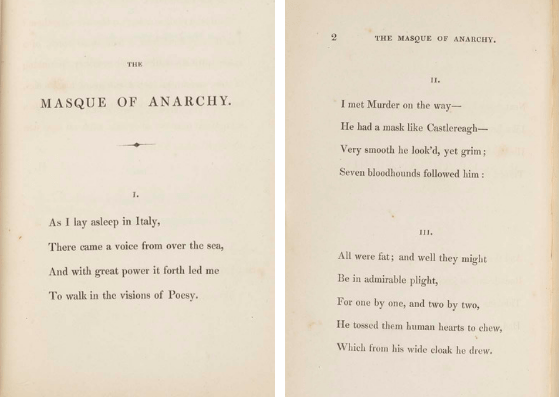Gallery Assistant Tamsin Key writes about The Masque of Anarchy by Percy Bysshe Shelley:
Our displayed copy of this poem is printed in a small book tucked in the corner of a display case, but its power and longevity far exceed its size.
On 16th August 1819 an estimated 60,000 men, women and children arrived in what is now St Peter’s Square in Manchester. Many of them were dressed in their Sunday best and had walked from the surrounding towns and countryside. They were there to hear radical speaker Henry Hunt discuss widening the franchise and the reform of political representation. The electorate at the time was just 3% of the population, and growing cities such as Leeds, Manchester and Birmingham had no MP. The working people were struggling due to increasing food prices and the effects of the Industrial Revolution, and they were desperate for representation at Westminster.
Despite the gathering being legal and orderly, local magistrates decided to bring it to an end. They ordered cavalry and other troops to advance, which they did with sabers drawn, and twenty minutes later only bodies and the injured remained. It is estimated that at least 15 died and approximately 700 were injured. A Waterloo veteran said before he died, “At Waterloo there was man to man, but here it was downright murder.”
The news arrived in Italy a few weeks later. Mary Shelley wrote, “When the news reached us it roused in Shelley violent emotions of indignation and compassion.” Percy Bysshe Shelley went on to write The Masque of Anarchy, naming and shaming the political leaders of the day for their support of the actions at Peterloo, and their ongoing policies restricting free speech and public demonstrations. He renames them Murder, Fraud and Hypocrisy and describes them tossing human hearts to feed their dogs, and weeping tears of millstone, dashing out the brains of children. Shelley felt that Anarchy was the only way to describe the conduct of the authorities and its effect on the people. The poem ends with the victory of Love and Hope over Anarchy, bringing in a new, fairer society.
Shelley sent the poem to Leigh Hunt, his publisher and friend, who felt publication would be too risky. It was finally published posthumously in 1832 after the passing of the Great Reform Act, though still many years before the Universal Suffrage sought by the protesters.
The poem has continued to resonate. It inspired Gandhi’s policy of non-violent resistance and was read in Tiananmen Square in 1999 and Tahrir Square in 2011. It features on the back sleeve of The Jam’s 1980 album Sound Affects and was read by Maxine Peake in 2013 on the site of the Peterloo massacre. Shelley’s phrase “Ye are many, they are few” has been used in many political speeches and slogans up to the present day. It continues to connect us to the passion for change felt by both those caught up in the massacre, and subsequent and ongoing campaigns for equality and fairness.

